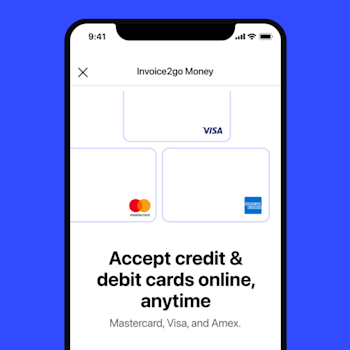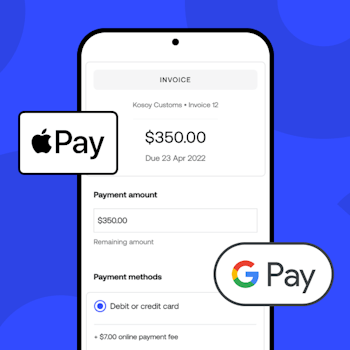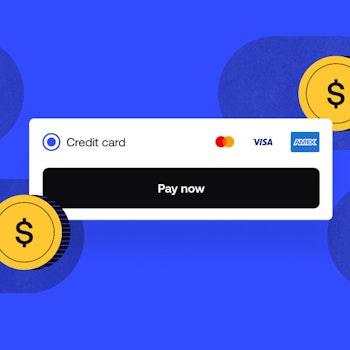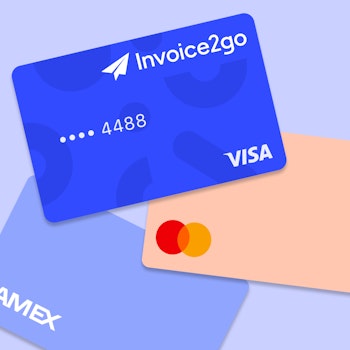
How to price your services as a freelancer or small business owner
Knowing how to price your services is essential to your success. Still, setting your price can evoke a range of emotions from confusion to dread. How do you price yourself competitively and ensure you’re not underpaid?
You want to keep cash flow strong, confidence up, and know your customers are getting great value. Every. Single. Time. You want more mic drop moments and fewer instances of self-doubt. That’s where the proper pricing strategy comes into play.
We’re here to help. At Invoice2go, a Bill.com company, we offer straightforward tools that simplify the admin side of running a business. We’re also dedicated to unlocking the secrets of running a successful business and passing on expert tips to you.
Ready to set the perfect price for your service? Follow these 6 steps:
1. Calculate all your costs
Even if you work from your laptop at home, running a business isn’t free – you’ve got bills to pay. What are they? Open up a file on your computer and write down the exact numbers that fall into these two categories.
Direct costs
These are the costs that go directly toward providing services for your customers. For example, suppose you run a plumbing or carpentry business. In that case, you need to include:
Indirect costs
There’s more to running a business than simply paying your employees and purchasing project supplies. You can’t run your business if your internet, cell phone, and electricity bill aren’t paid.
Other indirect costs could include:
- Rent
- Subscriptions you use for your business
- Utilities
- Insurance
- Devices you use for work (smartphones, tablets, etc.)
- Marketing and advertising
- Website and social media
- Accounting services
- Legal services
These costs all add up, and you need to ensure that the price you charge covers all out-of-pocket expenses and leaves you with a profit.
Compile an accurate accounting of known and anticipated costs, breaking it down to understand what you need to bring in monthly, weekly, or even hourly. Then, factor in a fair profit margin when you’re setting a price for services.
It’s really about understanding what your time is worth, and that starts with knowing what each hour of the workday costs you. This knowledge allows you to set a base price for services and adjust for estimated time, necessary labor and supplies, relative difficulty, and other factors that relate to specific types of projects.
2. Do some market research
Once you’ve calculated how much you need to earn just to break even, the next step is determining what prospective customers are willing to pay. This is rather difficult to anticipate because value is subjective.
You need to offer an appealing value proposition if you hope to convince people to pay what you think you’re worth. When you’re starting market research, there are several things to keep in mind.
First and foremost, never reveal your numbers. It can be tempting to ask people if they’ll pay the number you have in mind, but you’ll gain more insight by simply telling them what service you’re offering, asking them to provide a number that they would pay, and then learning whether they think your service is worth that amount.
Get feedback from your network or consider a focus group
One good way to do this is to conduct a focus group. Ideally, you’ll want to include potential customers, but if you’ve never done this before, it might be best to perform a test run with a group of family members and friends to try your script and get some feedback.
When running a focus group, you might be surprised to learn that direct questioning may not be your best line of attack. You’ll gain better insights by understanding consumer problems related to your services and learning which solutions they currently rely on, as well as how much they pay for them.
You can also ask what they think their current service provider lacks and how much they might pay for a service that better suits their needs. This, in turn, can help you tailor your service offerings and set reasonable prices simultaneously.
The next step is to launch a marketing effort. Using a list of targeted leads, send emails detailing services and costs and see if you gain any interest. Be sure to follow up with leads that don’t respond. Contact them directly -- ideally by phone -- to discuss which services they might be interested in and how they feel about your rates.
Here are some more useful tips from MasterClass to help you learn how to run a focus group.
3. Check out your competition
If your business operated in a bubble, your costs, perceived value, and the amount that customers would be willing to pay might be the only factors in setting pricing for services. In the real world, however, you also have to factor in competitors. You’ll need to think through how they compare to you in various categories, including what services they provide, what they charge, and how consumers rate them.
The best place to start is by seeking out competitors on various marketplaces, such as Google, Yelp, Fiverr, Upwork, and Thumbtack. You’ll want to focus primarily on the platforms you currently use or any that you’re considering using to market your business.
When you’re researching competitors, you’ll find that it’s rarely an apples-to-apples comparison, so pay attention not only to pricing but also:
- Price scales
- Specific services and service packages
- Experience level
- Location and related demographic data
- Target customers
What can you learn from this data? You’ll learn how your business is similar to competitors and how you stand out.
You might also discover niche demographics that no one is yet filling, which you may be able to slip into. You could find that rates vary by geography or that similar services are viewed as more valuable based on how they are named or presented.
There’s no reason to reinvent the wheel, however. With competitive research, you have the opportunity to size up the competition, benefit from their work, and use your knowledge to get a leg up or find an underserved and valuable niche.
4. Run a test
If you’re having trouble getting feedback about pricing from prospective customers, or if your current pricing hasn’t resulted in significant business coming in, it may be time to take a bold step. Consider going directly to the source and asking consumers what they’re willing to pay.
Instead of listing service prices on your website, share what you have to offer and invite consumers to name their price. You can phrase it as a “contact us for pricing,” “pay what you want,” or “tell us your budget” option, but the objective is the same: To compel consumers to contact you directly and discuss what they feel is a fair price for your service.
Don’t be too judgmental. Understand that people seeking your services may have small budgets, may not be familiar with your service, or know what competitors are charging.
Take this opportunity to determine what prospective clients are willing to pay and whether they might prefer piecemeal services or packages they can save on. You can also explore whether one-time or subscription services are more appealing.
If you try this tactic, be prepared to offer some services at discounted rates, understanding that the feedback you’re receiving provides additional value. The data you collect can help you understand your market better and create the services and price points most likely to attract business.
5. Define your strategy
Once you have a clear idea of your costs and what prospective customers are willing to pay for the solutions you can offer, it’s time to think about the best pricing strategies.
You’ll need to create business goals, consider your pricing structure, and determine how to entice new clients to try out your services so you can get a foot in the door and start building lasting relationships.
Business goals
As noted above, it’s not enough to simply break even and cover your costs. You need to make a profit so that you can reinvest in your business, create a cushion to account for inconsistencies in cash flow, and eventually expand.
Whether you run a freelance operation or a more typical 9-to-5, it’s essential to consider how much work you need to bring in to cover costs and turn a profit at different price points for services. A simple tool like the Breakeven Analysis Calculator can help you crunch numbers quickly with a few simple inputs.
Pricing metrics
The pricing structure you choose is essential. It affects how customers perceive your business. For example, if you charge by the hour or create a day rate for work, customers will naturally want estimates on timing for their project so they can plan for anticipated expenses. This means you will need to accurately assess how long tasks will take to meet customer expectations and turn a profit.
If you price based on deliverables or set a fixed fee, you’ll need to create categories with standard prices for specific types of work, corresponding with the time and difficulty involved. Consider what competitors are doing, as well as what consumers seem to prefer based on your market research when you’re determining the best pricing structure for your business.
Ensure to factor in the amount of time you spend generating leads and completing conversions (i.e., clinching memberships, making sales, etc.). If you have to put a lot of time into converting leads to sales, reflect that time and effort in your pricing.
Free consultations and introductory rates
Sometimes, converting leads means dangling a carrot – in this case, a discount or freebie. Once you have an established client list and you’re generating leads through word-of-mouth advertising and positive consumer reviews, you can set pricing as you see fit. Still, in the beginning, it’s essential to entice consumers, so you have the opportunity to prove yourself.
Many businesses start by offering “get to know you” options, like a free consultation. This gives you a chance to prove yourself to prospective clients before asking them to lay out any cash. A short free trial may be another option to explore, depending on the type of services you offer.
You can also start new customers with low introductory rates to show them the value they’ll gain by continuing to use your services, even when rates revert to normal.
6. Put your pricing strategy into action!
After all of your research, you should have a good idea of the minimum you need to charge, what consumers are willing to pay, and how you can best offer services that appeal to your target demographic. This will help you to create an attractive pricing structure to drive business and set a minimum rate that results in some profit.
Not sure how much to charge over your break-even price? A good rule of thumb is to have a minimum of 10% in profit margin, but remember, it will depend somewhat on the business that you bring in.
It’s always good to offer multiple price points for different services to attract consumers working with different budgets. Consider offering a variety of packages that create opportunities for customers to bundle and save on services.
By creating low- and high-priced packages, you can drive average customers toward the middle. You might also want to offer loyalty or reward-based pricing to encourage repeat business.
Although you shouldn’t deviate from set pricing, it’s always wise to adopt a flexible attitude. When you’re creating contracts that spell out the terms of services and pricing, consider offering options for custom packages or the possibility of updating contracts for additional services down the road. This will help you prepare for the unexpected and facilitate project adjustments to meet customer needs without losing money.
Once you’ve got your pricing structure nailed down, Invoice2go is here to help you quickly create estimates, track project expenses, generate and send invoices, and offer easy online payment options. If you're looking for ways to simplify running your business, check us out.
Related Articles

How to accept credit card payments on Invoice2go in 3 simple steps

Accept payments online via Apple Pay and Google Pay

Must-not-miss write-offs as you wrap up 2022 year-end finances

5 ways accepting credit and debit card payments helps your business stay resilient

4 easy ways to increase cash flow today

What is Small Business Saturday and why is it important?
The features and surprising benefits of a well-designed packing slip
